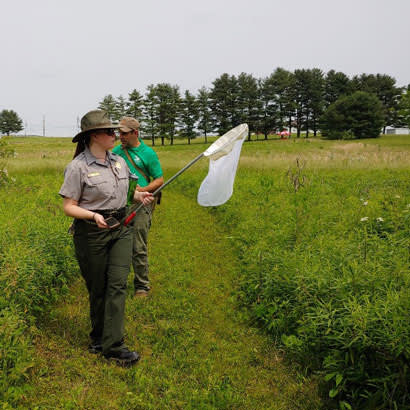
Last year during NRPA’s Parks for Pollinators BioBlitz, I hosted a Pollinator BioBlitz at a newly established pollinator habitat behind my office at Atwood Dam in Mineral City, Ohio. I saw the opportunity to not only highlight the newly created habitat, but also document the species, both plant and pollinator, in this new habitat.
While this was my first time hosting a BioBlitz, I knew including other local groups would ensure a great event. I enlisted several local agencies and individuals to help out, including Denise Ellsworth, an Entomologist from the Ohio State University Bee Lab; Rome Marinelli, co-founder of the local nonprofit SWARM that advocates for native habitat to protect pollinators; and Gary Conley and Jennifer Windus, board members of the Ohio Invasive Plant Council. They all volunteered their time to be expert identifiers for the event — Ellsworth identified bees and insects, Marinelli identified native plants, and Conley and Windus identified native and invasive plant species in the four-acre habitat.
The event was established on the iNaturalist app, where group members could take pictures and upload them to the app for proper identification of the species. There were more than 60 observations and 40+ different species identified. Some species that were found included Common Milkweed, Wing Stem, Butterfly Weed, Hemp Dogbane, Shrubby St. John’s Wort, Riverbank Grape, Foxglove Beardtongue, White and Red Clovers, and various bees, beetles and butterflies.
Since the BioBlitz, I have used the information gathered to inform future plans for the site. Which included hosting an invasive species removal day with at-risk youth from a local high school in September 2019 for National Public Lands Day. To start the day, students answered trivia questions about Multiflora Rose and Autumn Olive, learned how to identify the invasive species and then used hand tools to remove the species — and they had a blast! We also did a seed casting in the winter at the site in hopes to create a more diverse habitat.
Plans for the pollinator habitat moving forward include continuing to manage invasive species by removing and treating large “parent” Autumn Olive plants that line the habitat; mowing and treating plots throughout the habitat to plant clusters of specific native plants such as Common Milkweed, Purple Coneflower, Hollow Joe Pye, and Butterfly Milkweed, to name a few; working with a local high school’s shop class to build native bee hotels and Chimney Swift towers; and hosting another BioBlitz this September to continue to monitor how the habitat is establishing.
We also want to open the habitat to the public one day for self-guided interpretive hikes and work with local schools to engage them in environmental education programs with the habitat.
Interested in learning more about BioBlitzes? You can also sign up to host a Parks for Pollinators BioBlitz this September in your own community and receive tools to help you plan with physical distancing in mind. If your agency signs up to host a BioBlitz during the month of September, not only will you be helping raise pollinator awareness, you will also be entered to win a $1,000 prize and one of three Scotts Miracle-Gro prize packs to help with your pollinator habitats or programs!
Grace Trimble is a Park Ranger/Natural Resource Specialist for the U.S. Army Corps of Engineers in the Huntington District of the Great Lakes and Rivers Division. She works at five dams in Ohio - Atwood, Beach City, Bolivar, Dover and Leesville Dams.

